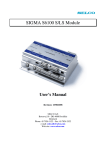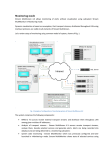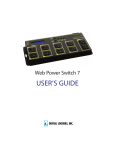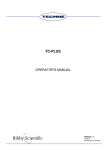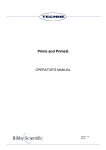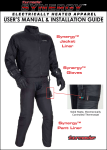Download VFC
Transcript
Frequency Converter type Vacon NX for Alimak’s Hoists and Lifts User’s Manual This manual is only applicable if the manufacturing number indicated below corresponds to the manufacturing number stamped on the identification sign of the equipment. Where there is a conflict contact your ALIMAK representative. Manufacturing No.: Year: If the bottom right corner of this book is cut, the book is only valid for illustrative use! Part No. 9081536 - 1 01 2004 - 09 - 23 Photographs and drawings are illustrative only and do not necessarily show the design of the products on the market at any given point in time. The products must be used in conformity with applicable practice and safety regulations. Specifications of the products and equipment presented herein are subject to change without notice. A0 ALIMAK NX FREQUENCY CONVERTER 1. SAFETY................................................... A1 – A2 1.1 WARNINGS ................................................................ A1 1.2 SAFETY INSTRUCTIONS......................................... A1 1.3 EARTHING AND EARTH FAULT PROTECTION.. A2 1.4 RUNNING THE MOTOR ........................................... A2 2. GENERAL............................................... A3 – A4 2.1 INSTRUCTIONS FOR INSTALLATION ..................... 2.2 INSTRUCTIONS FOR INSULATION CHECKS ......... 2.2.1 Motor cable insulation checks ................................. 2.2.1 Mains cable insulation checks ................................. 2.2.1 Motor insulation checks ........................................... 3 4 4 4 4 3. CONTROL KEYPAD........................... A4 – A18 3.1 INDICATIONS ON THE KEYPAD DISPLAY ............ 5 3.1.1 Drive status indication ............................................. 5 3.1.2 Control place indications ......................................... 6 3.1.3 Status LEDs.............................................................. 6 3.1.4 Text lines................................................................... 6 3.2 KEYPAD PUSH-BUTTONS ........................................ 7 3.2.1 Button descriptions................................................... 7 3.3 NAVIGATION ON THE CONTROL KEYPAD........... 8 3.3.1 Monitoring menu (M1)........................................... 10 3.3.2 Parameter menu (M2) ............................................ 11 3.3.3 Active faults menu (M4) ......................................... 13 3.3.4 Fault types.............................................................. 14 3.3.5 Fault codes ............................................................. 14 3.3.6 Fault time data record............................................ 15 3.3.7 Fault history menu (M5) ........................................ 15 3.3.8 System menu (M6) .................................................. 16 3.3.9 Copy parameters .................................................... 18 4. FAULT TRACING.............................. A19 – A23 4.1 VERIFYING THE PULSE ENCODER FUNCTION /DIRECTION .......................................... 23 ALIMAK 34848 - 1/01 A1 SAFETY ONLY A COMPETENT ELECTRICIAN MAY CARRY OUT THE ELECTRICAL INSTALLATION / SERVICE 1.1 Attention – The components of the power unit of the frequency converter are live when Vacon NX is connected to mains potential. Coming into contact with this voltage is extremely dangerous and may cause death, or severe injury. The control unit is isolated from the potential. – The motor terminals U, V, W and the DC-link/brake resistor terminals – / + are live when Vacon NX is connected to mains, even if the motor is not running. i4 – The control I/O-terminals are isolated from the mains potential. However, the relay outputs and other I/Oterminals may have a dangerous control voltage present even when Vacon NX is disconnected from mains. – The frequency converter has a large capacitive leakage current. – Only spare parts delivered by Vacon must be used. f4 1.2 Safety instructions – The Vacon NX frequency converter is meant for fixed installations only. – Do not perform any measurements when the frequency converter is connected to the mains. – After disconnecting the frequency converter from the mains, wait until the fan stops and the indicators on the keypad go out (if no keypad is attached see the indicators on the cover). Wait 5 more minutes before doing any work on Vacon NX connections. Do not even open the cover before this time has expired. – Do not perform any voltage withstand tests on any part of Vacon NX. There is a certain procedure according to which the tests shall be performed. Ignoring this procedure may result in damaged product. – Prior to measurements on the motor or the motor cable, disconnect the motor cable from the frequency converter. – Do not touch the IC-circuits on the circuit boards. Static voltage discharge may damage the components. – Before connecting the frequency converter to mains make sure that theVacon NX front and cable covers are closed. ALIMAK 34849 - 1/01 A2 Earth = Ground 1.3 Earthing and earth fault protection The Vacon NX frequency converter must always be earthed with an earthing conductor connected to the earthing terminal. The earth fault protection inside the frequency converter protects only the converter itself against earth faults in the motor, or the motor cable. Due to the high capacitive currents present in the frequency converter, fault current protective switches may not function properly. If fault current protective switches are used they must be tested with the drive with earth fault currents that are possible to arise in fault situations. 1.4 Running the motor Warning symbols For your own safety, please pay special attention to the instructions marked with the following symbols: ALIMAK 34850 - 1/01 A3 2. General The VFC unit feeds a variable frequency to the motor(s) to give a stepless speed control of the hoist/lift. In order to keep the same motor torque the VFC also controls the output voltage to the motor(s). The VFC unit is specially designed for Alimak hoist/lift application, both hardware and software. The VFC-unit has special software developed for use with Alimak hoists and cannot be replaced with another VFC-unit. 2.1 Instructions for installation of VFC-hoist Following procedure is valid for installation of Alimak VFChoists, which are erected for the first time or erected after being moved from one site to another. This procedure must be followed before the hoist can be used either in normal or Inspection mode. The hoists can handle all voltages in their range, but certain measures must be taken. Procedure: 1. Make sure that you have the relevant parameter list for the actual lift/hoist. This is supplied within the electrical documentation. 2. Put the main switch on the M- and B-panel in the off position. 3. Connect the incoming power to the B-panel. 4. Measure the incoming voltage in the B-panel (after eventual step-up or step–down trafo). 5. Check that the connections P1 – P8 on the primary side of the control transformer in the M-panel, (also B-panel if equipped with control transformer), correspond to the incoming voltage. If not, adjust the connections according to the chart on the transformer/electrical drawings. 6. Energize the M-panel by switching on the main switches on the B- and M-panel. 7. If the VFC unit has been replaced with a spare unit, check all parameters according to the relevant parameter list. See section 3 for procedure. ALIMAK 34851 - 1/01 A4 2.2 Instructions for insulation checks of VFC-hoist 2.2.1 Motor cable insulation checks Disconnect the motor cable from terminals U, V and W of the frequency converter and from the motor. Measure the insulation resistance of the motor cable between each phase conductor, as well as between each phase conductor and the protective ground conductor. The insulation resistance must be >1MΩ. 2.2.2 Mains cable insulation checks Disconnect the mains cable from terminals L1, L2 and L3 of the frequency converter and from the mains. Measure the insulation resistance of the mains cable between each phase conductor, as well as between each phase conductor and the protective ground conductor. The insulation resistance must be >1MΩ. 2.2.3 Motor insulation checks Disconnect the motor cable from the motor and open the bridging connections in the motor connection box. Measure the insulation resistance of each motor winding. The measurement voltage must be equal with at least the motor nominal voltage, but not exceed 1000 V. The insulation resistance must be >1MΩ. 3. CONTROL KEYPAD The control keypad is the link between the Vacon frequency converter and the user. The Vacon NX control keypad features an alphanumeric display with seven indicators for the Run status (RUN, , READY, STOP, ALARM, FAULT) and three indicators for the control place (I/O term/ Keypad/BusComm). There are also three Status Indicator LEDs (green - green - red), see below. The control information, i.e. the number of menu, description of menu or the displayed value and the numeric information are presented on three text lines. The frequency converter is operable through the nine pushbuttons of the control keypad. Furthermore, the buttons serve the purposes of parameter setting and value monitoring. The keypad is detachable and isolated from the input line potential. ALIMAK 34852 - 1/01 A5 3.1 Indications on the Keypad display Figure 3 – 1. Vacon control keypad and drive status indications 3.1.1 Drive status indications The drive status indications tell the user what the status of the motor and the drive is and whether the motor control software has detected irregularities in motor or frequency converter functions. RUN = Motor is running; Blinks when the stop command has been given but the frequency is still ramping down. = Indicates the direction of motor rotation. STOP = Indicates that the drive is not running. READY = Lights when AC power is on. In case of a trip, the symbol will not light up. ALARM = Indicates that the drive is running outside a certain limit and a warning is given. FAULT = Indicates that unsafe operating conditions were encountered due to which the drive was stopped. ALIMAK 34853 - 1/01 A6 3.1.2 Control place indications The symbols I/O term, Keypad and Bus/Comm (see Figure 3–1) I/O term = I/O terminals are the selected control place; i.e. START/STOP commands or reference values etc. are given through the I/O terminals. Keypad = Not used. Bus/Comm = The frequency converter is controlled through a fieldbus. 3.1.3 Status LEDs The status LEDs light up in connection with the READY, RUN and FAULT drive status indicators. = Illuminates with the AC power connected to the drive. Simultaneously, the drive status indicator READY is lit up. = Illuminates when the drive is running. Blinks when the STOP button has been pushed and the drive is ramping down. = Illuminates when unsafe operating conditions were encountered due to which the drive was stopped (Fault Trip). Simultaneously, the drive status indicator FAULT blinks on the display and the fault description can be seen, see chapter 3.3.3, Active Faults. 3.1.4 Text lines The three text lines (•, ••, •••) provide the user with information on his present location in the keypad menu structure, as well as with information related to the operation of the drive. = Location indication; displays the symbol and number of menu, parameter etc. Example: M2 = Menu 2 (Parameters); P2.1.3 = Acceleration time = Description line; Displays the description of menu, value or fault. = Value line; Displays the numerical and textual values of references, parameters etc. and the number of submenus available in each menu ALIMAK 34854 - 1/01 A7 3.2 Keypad push-buttons The Vacon alphanumeric control keypad features 9 pushbuttons that are used for the control of the frequency converter (and motor), parameter setting and value monitoring. Figure 3 – 2. Keypad push-buttons 3.2.1 Button descriptions = This button is used to reset active faults (see Chapter 3.3.3). = This button is used to switch between two latest displays. May be useful when you want to see how the changed new value influences some other value. = The Enter button serves for: 1) confirmation of selections 2) fault history reset (2…3 seconds) = Browser button up Browse the main menu and the pages of different submenus. Edit values. = Browser button down Browse the main menu and the pages of different submenus. Edit values. = Menu button left Move backward in menu. Move cursor left (in parameter menu). Exit edit mode. Hold down for 2…3 seconds to return to main menu. ALIMAK 34855 - 1/01 A8 = Menu button right Move forward in menu. Move cursor right (in parameter menu). Enter edit mode. = Start button. (Not normally used for Start in Alimak application) = Stop button. (Not normally used for Stop in Alimak application) 3.3 Navigation on the control keypad The data on the control keypad are arranged in menus and submenus. The menus are used for example for the display and editing of measurement and control signals, parameter settings (chapter 3.3.2), reference values and fault displays (chapter 3.3.3). The first menu level consists of menus M1 to M7 and is called the Main menu. The user can navigate in the main menu using the Browser buttons up and down. The desired submenu can be entered from the main menu using the Menu buttons. When there are still pages to enter under the currently displayed menu or page, you can see an arrow in the lower right corner of the display and by pressing the Menu button right, you can reach the next menu level. The control keypad navigation chart is shown on the next page. Please note that the menu M1 is located in the lower left corner. From there you will be able to navigate your way up to the desired menu using the menu and browser buttons. ALIMAK 34856 - 1/01 A9 Figure 3 - 3. Keypad navigation chart ALIMAK 34857 - 1/01 A 10 3.3.1 Monitoring menu (M1) You can enter the Monitoring menu from the Main menu by pushing the Menu button right when the location indication M1 is visible on the first line of the display. How to browse through the monitored values is presented in Figure 3-4. The monitored signals carry the indication V#.# and they are listed in Table 3-1. The values are updated once every 0.3 seconds. This menu is meant only for signal checking. The values cannot be altered here. For changing values of parameters see Chapter 3.3.2. Figure 3 - 4. Monitoring menu Code Signal name Unit Description V1.1 Output frequency Hz V1.2 Frequency reference Hz V1.3 Motor speed rpm Calculated motor speed V1.4 Motor current A Measured motor current V1.5 Motor torque % Calculated actual torque/nominal torque of the unit V1.6 Motor power % Calculated actual power/nominal power of the unit V1.7 Motor voltage V Calculated motor voltage V1.8 DC-link voltage V Measured DC-link voltage V1.9 Unit temperature ºC Heat sink temperature V1.10 Voltage input V AI1 V1.11 Current input mA V1.12 DIN1, DIN2, DIN3 Digital input statuses V1.13 DIN4, DIN5, DIN6 Digital input statuses V1.14 DO1, RO1, RO2 Digital and relay output statuses V1.15 Analogue output current mA AO1 V1.15 Encoder speed rpm Encoder speed in rpm M1.17 Multimonitoring items Frequency to the motor AI2 Displays three selectable monitoring values. Table 3-1. Monitored signals ALIMAK 34858 - 1/01 3.3.2 Parameter menu (M2) Parameters are the way of conveying the commands of the user to the frequency converter. The parameter values can be edited by entering the Parameter Menu from the Main Menu when the location indication M2 is visible on the first line of the display. The value editing procedure is presented in Figure 3-5. Push the Menu button right once to move into the Parameter Group Menu (G#). Locate the parameter group desired by using the Browser buttons and push the Menu button right again to enter the group and its parameters. Use again the Browser buttons to find the parameter (P#) you want to edit. From here you can proceed in two different ways: Pushing the Menu button right takes you to the edit mode. As a sign of this, the parameter value starts to blink. You can now change the value in two different manners: 1 Just set the new desired value with the Browser buttons and confirm the change with the Enter button. Consequently, the blinking stops and the new value is visible in the value field. 2 Push the Menu button right once again. Now you will be able to edit the value digit by digit. This editing manner may come in handy, when a relatively greater or smaller value than that on the display is desired. Confirm the change with the Enter button. ALIMAK 34859 - 1/01 A 11 A 12 The value will not change unless the Enter button is pushed. Pressing the Menu button left takes you back to the previous menu. Several parameters are locked, i.e. uneditable, when the drive is in RUN status. If you try to change the value of such a parameter the text *Locked* will appear on the display. The frequency converter must be stopped in order to edit these parameters. You can return to the Main menu anytime by pressing the Menu button left for 1 – 2 seconds. Once in the last parameter of a parameter group, you can move directly to the first parameter of that group by pushing the Browser button up. Figure 3 – 5. Parameter value change procedure ALIMAK 34860 - 1/01 A 13 3.3.3 Active faults menu (M4) The Active faults menu can be entered from the Main menu by pushing the Menu button right when the location indication M4 is visible on the first line of the keypad display. When a fault brings the frequency converter to a stop, the location indication F1, the fault code, a short description of the fault and the fault type symbol (see Chapter 3.3.4) will appear on the display. In addition, the indication FAULT or ALARM (see Figure 3 – 1 or Chapter 0) is displayed and, in case of a FAULT, the red led on the keypad starts to blink. If several faults occur simultaneously, the list of active faults can be browsed with the Browser buttons. The memory of active faults can store the maximum of 10 faults in the order of appearance. The display can be cleared with the Reset button and the read-out will return to the same state it was before the fault trip. The fault remains active until it is cleared with the Reset button, or with a reset signal from the I/O terminal. Note ! Remove external Start signal before resetting the fault to prevent unintentional restart of the drive. 3.3.4 Fault types In the NX frequency converter, there are four different types of faults. These types differ from each other on the basis of the subsequent behaviour of the drive. See Table 3 – 2. Figure 3 - 6. Fault display ALIMAK 34861 - 1/01 A 14 Fault type symbol Meaning A (Alarm) This type of fault is a sign of an unusual operating condition. It does not cause the drive to stop, nor does it require any special actions. The 'A fault' remains in the display for about 30 seconds. F (Fault) An 'F fault' is a kind of fault that makes the drive stop. Actions need to be taken in order to restart the drive. AR (Fault Autoreset) If an 'AR fault' occurs the drive will also stop immediately. The fault is reset automatically and the drive tries to restart the motor. Finally, if the restart is not successful, a fault trip (FT, see below) occurs. FT (Fault Trip) If the drive is unable to restart the motor after an AR fault an FT fault occurs. The effect of the 'FT fault' is basically the same as that of the F fault: the drive is stopped. Table 3 - 2. Fault types 3.3.5 Fault codes The fault codes, their causes and correcting actions are presented in the table last in this manual. 3.3.6 Fault time data record When a fault occurs the information described above in 3.3.3 is displayed. By pushing the Menu button right here you will enter the Fault time data record menu indicated by T.1 T.13. In this menu, some selected important data valid at the time of the fault are recorded. This feature is intended to help the user or the service person to determine the cause of fault. The data available are: T.1 Counted operation days (Fault 43: Additional code) T.2 Counted operation hours (Fault 43: Counted operation days) hh:mm:ss (d) T.3 Output frequency (Fault 43: Counted operation hours) Hz (hh:mm:ss) T.4 Motor current A T.5 Motor voltage V T.6 Motor power % T.7 Motor torque % T.8 DC voltage V T.9 Unit temperature °C T.10 Run status T.11 Direction T.12 Warnings T.13 0-speed* ALIMAK 34862 - 1/01 d A 15 Real time record If real time is set to run on the frequency converter the data items T1 and T2 will appear as follows: T.1 Counted operation days yyyy-mm-dd T.2 Counted operation hours hh:mm:ss,sss 3.3.7 Fault history menu (M5) The Fault history menu can be entered from the Main menu by pushing the Menu button right when the location indication M5 is visible on the first line of the keypad display. All faults are stored in the Fault history menu in which you can browse through them using the Browser buttons. Additionally, the Fault time data record pages (see Chapter 3.3.6) are accessible at each fault. You can return to the previous menu anytime by pushing the Menu button left. The memory of the frequency converter can store a maximum of 30 faults in the order of appearance. The number of faults currently in the fault history is shown on the value line of the main page (H1 H#). The order of the faults is indicated by the location indication in the upper left corner of the display. The latest fault carries the indication F5.1, the second latest F5.2 etc. If there are 30 uncleared faults in the memory the next occurring fault will erase the oldest from the memory. Pressing the Enter button for about 2 to 3 seconds resets the whole fault history. Then, the symbol H# will change to 0. Figure 3-7. Fault history menu ALIMAK 34863 - 1/01 A 16 3.3.8 System menu (M6) The System menu can be entered from the main menu by pushing the Menu button right when the location indication M6 is visible on the display. The controls associated with the general use of the frequency converter, such as parameter sets or information about the hardware and software are located under the System menu. The number of submenus and subpages is shown with the symbol S (or P) on the value line. Functions in the System menu Code Function Min Max Unit Default Selections S6.1 Language selection English English S6.2 Application selection S6.3 Copy parameters S6.3.1 Parameter sets Store set 1 Load set 1 Store set 2 Load set 2 Load factory defaults S6.3.2 Load up to keypad All parameters S6.3.3 Load down from keypad All parameters All but motor parameters Application parameters P6.3.4 Parameter backup S6.4 Compare parameters S6.5 Security Alimak Lift No Alimak Lift Yes No S6.5.1 Password Not used 0=Not used P6.5.2 Parameter lock Change Enabled S6.5.3 Start-up wizard Change Enabled Change Disabled No Yes S6.5.4 Multimonitoring items S6.6 Keypad settings P6.6.1 Default page P6.6.2 Default page/ Operating menu P6.6.3 Timeout time 0 65535 P6.6.4 Contrast 0 31 P6.6.5 Backlight time S6.7 Hardware settings P6.7.1 Internal brake resistor P6.7.2 Fan control P6.7.3 HMI acknowledg.timeout P6.7.4 HMI number of retries Change Enabled Change Disabled Always 65535 min s 30 18 10 Not connected Temperature 200 5000 1 10 ms ALIMAK 34864 - 1/01 200 5 Not connected Connected Continuous Temperature A 17 Code Function S6.8 System information S6.8.1 Total counters C6.8.1.1 MWh counter kWh C6.8.1.2 Power On day counter C6.8.1.3 Power On hours counter hh:mm:ss S6.8.2 Trip counters T6.8.2.1 MWh counter kWh T6.8.2.2 Clear MWh trip counter T6.8.2.3 Operating days trip counter T6.8.2.4 Operating hour trip counter T6.8.2.5 Clear operating time counter S6.8.3 Software info S6.8.3.1 Software package S6.8.3.2 System software version S6.8.3.3 Firmware interface S6.8.3.4 System load S6.8.4 Applications S6.8.4.1 Name of application Min Max Unit Default hh:mm:ss D6.8.4.#.1 Application ID D6.8.4.#.2 Applications Version: D6.8.4.#.3 Applications: Firmware interface S6.8.5 Hardware I6.8.5.1 Info: Unit power kW I6.8.5.2 Info: Unit voltage V I6.8.5.3 Info: Brake chopper I6.8.5.4 Info: Brake resistor S6.8.6 Expander boards S6.8.7 Debug S6.8.9 Debug Power S6.8.11 Debug Power ALIMAK 34865 - 1/01 Selections A 18 3.3.9 Copy parameters The parameter copy function is used when the operator wants to copy one or all parameter groups from one drive to another. All the parameter groups are first uploaded to the keypad, then the keypad is connected to another drive and then the parameter groups are downloaded to it (or possibly back to the same drive). Before any parameters can successfully be copied from one drive to another the drive has to be stopped when the parameters are downloaded to it: The parameter copy menu (S6.3) embodies four functions: Parameter sets (S6.3.1) The Vacon NX frequency converter features a possibility for the user to load back the factory default parameter values and to store and load two customized parameter sets (all parameters included in the application). Alimak default parameter set is stored as Set1. On Parameter sets page (S6.3.1), push the Menu button right to enter the Edit menu. The text LoadFactDef begins to blink and you can confirm the loading of factory defaults by pushing the Enter button. The drive resets automatically. Alternatively you can choose any other of the storing or loading functions with the Browser buttons. Confirm with the Enter button. Wait until 'OK' appears on the display. ALIMAK 34866 - 1/01 A 19 4. FAULT TRACING When a fault is detected by the frequency converter control electronics, the drive is stopped and the symbol F together with the ordinal number of the fault, the fault code and a short fault description appear on the display. The fault can be reset with the Reset button on the control keypad or via the I/O terminal. The faults are stored in the Fault history menu (M5) which can be browsed. The different fault codes you will find in the table below. The fault codes, their causes and correcting actions are presented in the table below. The shadowed / yellow faults are A faults only. The items written in white on black background present faults for which you can program different responses in the application. See parameter group Protections. Note: When contacting distributor or factory because of a fault condition, always write down all texts and codes on the keypad display. ALIMAK 34867 - 1/01 f1 A 20 Fault code Fault Possible cause Correcting measures 1 Overcurrent Frequency converter has detected too high a current (>4*IH) in the motor cable: – sudden heavy load increase – short circuit in motor cables – unsuitable motor Check loading. Check motor. Check cables. 2 Overvoltage The DC-link voltage has exceeded the limits defined. – too short a deceleration time – high overvoltage spikes in supply Make the deceleration time longer. Use brake chopper or brake resistor (available as options) 3 Earth fault Current measurement has detected that the Check motor cables and motor. sum of motor phase current is not zero. – insulation failure in cables or motor 5 Charging switch The charging switch is open, when the START command has been given. – faulty operation – component failure 6 Emergency stop Stop signal has been given from the option board. 7 Saturation trip Various causes: – defective component – brake resistor short-circuit or overload Cannot be reset from the keypad. Switch off power. DO NOT RE-CONNECT POWER ! Contact factory. If this fault appears simultaneously with Fault 1, check motor cables and motor. 8 System fault – component failure – faulty operation Note exceptional fault data record, see 3.3.6. Reset the fault and restart. Should the fault re-occur, contact the distributor near to you. 9 Undervoltage DC-link voltage is under the voltage limits defined in. – most probable cause: too low a supply voltage – frequency converter internal fault In case of temporary supply voltage break reset the fault and restart the frequency converter. Check the supply voltage. If it is adequate, an internal failure has occurred. Contact the distributor near to you. 10 Input line supervision Input line phase is missing. Check supply voltage and cable. 11 Output phase supervision Current measurement has detected that there is no current in one motor phase. Check motor cable and motor. 12 Brake chopper supervision – no brake resistor installed – brake resistor is broken – brake chopper failure Check brake resistor. If the resistor is ok, the chopper is faulty. Contact the distributor near to you 13 Frequency converter Heatsink temperature is under –10°C undertemperature . ALIMAK 34868 - 1/01 Reset the fault and restart. Should the fault re-occur, contact the distributor near to you. Check Panel heater. A 21 Fault code Fault Possible cause Correcting measures 14 Frequency converter Heatsink temperature is over 90°C (or overtemperature 77ºC, NX_6, FR6). Overtemperature warning is issued when the heatsink temperature exceeds 85°C (72ºC). Check the correct amount and flow of cooling air. Check the heatsink for dust. Check the ambient temperature. Make sure that the switching frequency is not too high in relation to ambient temperature and motor load. 15 Motor stalled Motor stall protection has tripped. Check motor. 16 Motor overtemperature Motor overheating has been detected by frequency converter motor temperature model. Motor is overloaded. Decrease the motor load. If no motor overload exists, check the temperature model parameters. 17 Motor underload Motor underload protection has tripped. 22 EEPROM checksum fault Parameter save fault 23 FAULT – faulty operation – component failure 24 Counter fault Values displayed on counters are incorrect 25 Microprocessor watchdog fault – faulty operation – component failure Reset the fault and restart. Should the fault re-occur, contact the distributor near to you. 26 Start-up prevented Start-up of the drive has been prevented. Cancel prevention of start-up. 29 Thermistor fault The thermistor input of option board has Check motor cooling and loading detected increase of the motor Check thermistor connection temperature (If thermistor input of the option board is not in use it has to be short circuited). 31 IGBT temperature (hardware) IGBT Inverter Bridge overtemperature protection has detected too high a short term overload current 32 Fan cooling Cooling fan of the frequency converter Contact the distributor near to you. does not start, when ON command is given. 34 CAN bus communication Sent message not acknowledged. Ensure that there is another device on the bus with the same configuration. 36 Control unit NXS Control Unit can not control NXP Power Unit and vice versa Change control unit 37 Device changed (same type) Option board or control unit changed. Same type of board or same power rating of drive. Reset Note: No fault time data record! 38 Device added (same type) Option board or drive added. Drive of same power rating or same type of board added. Reset Note: No fault time data record! 39 Device removed Option board removed. Drive removed. Reset Note: No fault time data record! ALIMAK 34869 - 1/01 Check loading. Check motor size. A 22 Fault code Fault Possible cause Correcting measures 40 Device unknown Unknown option board or drive. Contact the distributor near to you. 41 IGBT temperature IGBT Inverter Bridge over temperature protection has detected too high a short term overload current Check loading. Check motor size. 42 Brake resistor over temperature Brake resistor over temperature protection has detected too heavy braking Set the deceleration time longer. Use external brake resistor. 43 Encoder fault Note the exceptional Fault data record. See 3.3.6. Additional codes: 1 = Encoder 1 channel A is missing 2 = Encoder 1 channel B is missing 3 = Both encoder 1 channels are missing 4 = Encoder reversed Check encoder channel connections. Check the encoder board. 44 Device changed (different type) Option board or control unit changed. Option board of different type or different power rating of drive. Reset Note: No fault time data record! Note: Application parameter values restored to default. 45 Device added (different type) Option board or drive added. Option board of different type or drive of different power rating added. Reset Note: No fault time data record! Note: Application parameter values restored to default. 50 Analogue input Iin < 4mA (sel. signal range 4 to 20 mA) Current at the analogue input is < 4mA. – control cable is broken or loose – signal source has failed Check the current loop circuitry. 51 External fault Digital input fault. 52 Keypad The connection between the control keycommunication fault pad and the frequency converter is broken. Check keypad connection and possible keypad cable. 53 Fieldbus fault The data connection between the fieldbus Master and the fieldbus board is broken Check installation. If installation is correct contact the nearest distributor. 54 Slot fault Defective option board or slot Check board and slot. Contact the nearest distributor. 56 PT100 board temp. fault Temperature limit values set for the PT100 board parameters have been exceeded Find the cause of temperature rise 80 Brake supervision External brake supervision signal has not been activated after the brake open signal is activated P2.7.24. 81 Brake logic supervision Brake open signal has not been activated after defined time after run request P2.7.25 82 Under current Motor current is less than set limit parameter P2.7.29 83 Shaft speed Shaft speed from encoder differs from the calculated shaft speed P2.7.30. ALIMAK 34870 - 1/01 A 23 Verifying the Pulse encoder function /direction – Set the lift/hoist in Inspection mode – Go to Parameter P 2.6.1. The setting should read "CL SpeedCtrl", which means Closed Loop Speed Control – Set the parameter P 2.6.1 to "OL Speed Cont", which means Open Loop Speed Control. – Go to Monitor V 1.16 Encoder Speed. – When you run the lift/hoist in the Up direction you should get a positive rpm value (for instance + 400). When you run the lift/hoist in the Down direction, you should get a negative rpm value (for instance -400). The actual rpm value depends on the motor rpm (speed). – Return the Parameter setting of P 2.6.1 to "CL SpeedCtrl". In case you don't get a value other than 0 when you run the lift/hoist, check the encoder connections. Try again. If you still don't get a value other than 0, the pulse encoder probably is broken. You have to replace it. If you get a negative value when going upwards and a positive value going downwards, check the encoder connections. You probably have switched the A and B pulses. ALIMAK 34871 - 1/01































